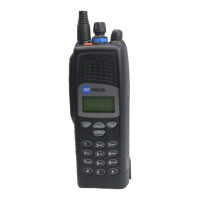212 Frequency Synthesizer Fault Finding TP9100 Service Manual
© Tait Electronics Limited May 2005
Task 38 —
TP501 Test Point
If the signal at the TP502 test point is correct, check the signal at the TP501
test point:
1. With the oscilloscope probe at the
TP501 test point
(see Figure 9.21), check the DAC output
CDC VCXO MOD.
If a sawtooth wave (1.8V
pp
) is present, go to Step 2. Otherwise go to
“VCXO and CODEC Circuitry” on page 214.
2. A fault is causing the loop to oscillate. If not already done, remove the
FCL TOP can.
3. Check the waveform at the
TP500 test point (see Figure 9.19).
The waveform should be an amplified and inverted version of the
waveform at the
TP501 test point.
4. If the waveform is correct, go to Step 5. If it is not, there is a fault in
the modulator buffer amplifier (IC502 pins 1 to 3, and associated
components) (see Figure 9.19). Rectify the fault and return to
Step 1.
5. Connect the
TP501 test point to ground by resoldering R527 in the
position shown in Figure 9.19. This forces the VCXO loop voltage
high.
6. Use the oscilloscope probe to check the VCXO output at C536 —
probe the via next to C536 (see Figure 9.19). The signal should be:
7. If the signal is correct, go to Ta s k 3 9
. If it is not, go to Step 8.
8. The VCXO circuitry is faulty. If not already done, remove the
VCXO BOT can.
9. Locate and repair the fault in the VCXO circuitry (Q501, Q503,
XL501 and associated components) (see Figure 9.20).
10. Confirm the removal of the fault, and go to Tas k 39
. If the repair
failed, replace the main board and go to “Final Tasks” on page 134.
VCXO output at C536: sine wave with frequency of 13.017MHz and
amplitude of 1.1 ± 0.2V
pp
on 1.4 ± 0.2V DC

